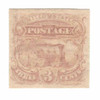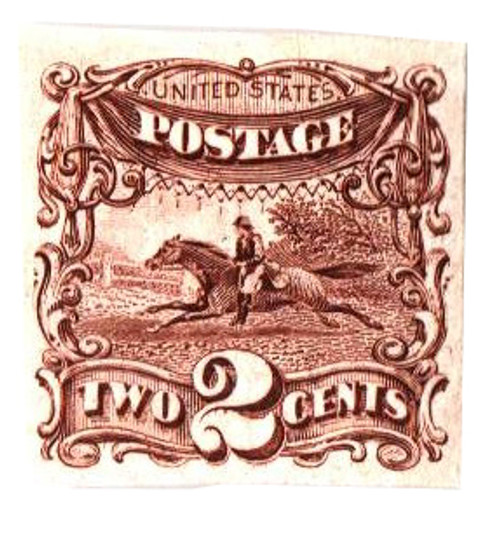
# 114-E5 - 1869 3c Die on India
Crisp 1869 Pictorial Plate Essay
Documents Evolution of a Classic...
Now you can own #114-E5, a plate essay of the 3¢ Pictorial stamp. This miniature work of art is a joy to own – and offers a compelling glimpse into U.S. postal history when compared to U.S. #114, the 3¢ Pictorial issued in 1869.
The Pictorials revolutionized U.S. stamp design. They were the first U.S. stamps to feature something other than a prominent American leader – and the first bi-color U.S. stamps.
Private firms submitted essays to demonstrate the high quality of their work – so very few were produced. And that’s a shame – these masterpieces represent an important step in philatelic history. Now you can get this seldom-seen, handsomely engraved treasure for your collection.
More About Essays
Essays are designs for stamp vignettes, stamp borders, or both combined, which were never approved and used in the final printing of a stamp. Even though a design is finally adopted with only slight modifications, it is still an "essay". To attain the status of a proof, a proposed design, or essay, must be exactly like the issued stamp for which it was submitted.
Private bank note companies made all U.S. stamps from 1847 to 1894. Essays and printing bids were submitted by those firms. As early as 1851, the U.S. Post Office Department established a policy of advertising for stamp proposals to be accompanied by essays, or examples of the stamps to be furnished. After the bids were opened, an Expert Committee was asked to rule on the designs, colors and paper.
Crisp 1869 Pictorial Plate Essay
Documents Evolution of a Classic...
Now you can own #114-E5, a plate essay of the 3¢ Pictorial stamp. This miniature work of art is a joy to own – and offers a compelling glimpse into U.S. postal history when compared to U.S. #114, the 3¢ Pictorial issued in 1869.
The Pictorials revolutionized U.S. stamp design. They were the first U.S. stamps to feature something other than a prominent American leader – and the first bi-color U.S. stamps.
Private firms submitted essays to demonstrate the high quality of their work – so very few were produced. And that’s a shame – these masterpieces represent an important step in philatelic history. Now you can get this seldom-seen, handsomely engraved treasure for your collection.
More About Essays
Essays are designs for stamp vignettes, stamp borders, or both combined, which were never approved and used in the final printing of a stamp. Even though a design is finally adopted with only slight modifications, it is still an "essay". To attain the status of a proof, a proposed design, or essay, must be exactly like the issued stamp for which it was submitted.
Private bank note companies made all U.S. stamps from 1847 to 1894. Essays and printing bids were submitted by those firms. As early as 1851, the U.S. Post Office Department established a policy of advertising for stamp proposals to be accompanied by essays, or examples of the stamps to be furnished. After the bids were opened, an Expert Committee was asked to rule on the designs, colors and paper.









